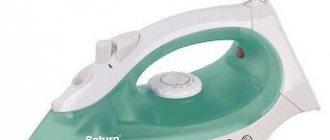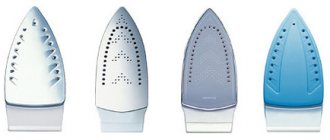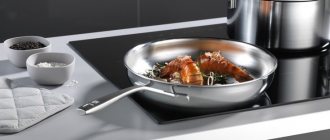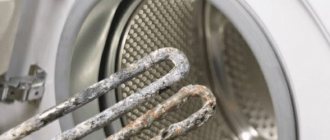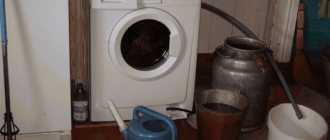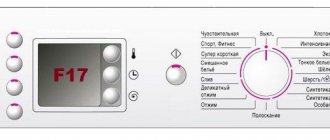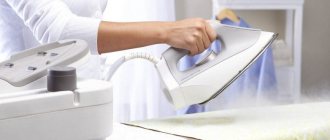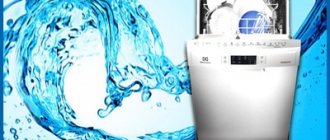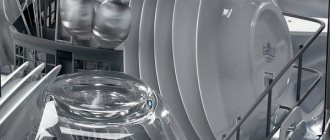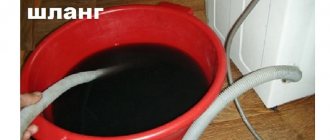Is it possible to fill?
Distilled water is obtained from ordinary water by distillation or evaporation.
At the same time, all impurities and mineral salts are removed from it. The result is 99% pure water. Therefore , it is believed that it is best used for a steamer.
In irons with this function, water is heated to a high temperature. Because of this, it turns into steam and is supplied under high pressure from special holes on the sole.
But if it contains mineral salts, they precipitate when heated. This is scale. It is deposited on the heating element, clogs the steam holes, and can get on clothes. Therefore, it is necessary to fill the steamer with water that is free of salts.
Reference! Many people believe that the best option is distilled. It definitely won't lead to scale formation.
Will it work from the tap?
All designs of steam generators have a heating element, which is designed for an average of 10 thousand hours of operation. This is an expensive part that is easily damaged due to scale formation. It is very difficult to replace heating elements, so you need to understand what kind of water is best to pour into the steamer.
Tap water must be discarded due to its high degree of hardness:
- mineral salts and lime form alkaline plaque and scale;
- scale not only clogs the steam holes, but ultimately leads to breakdown of the entire steamer;
- Due to lime, stains may appear on dark-colored fabrics.
There are water softeners, but their use is undesirable:
- promote the formation of chemical compounds;
- clog the device;
- Dirty streaks may appear on the fabric.
Important! Hard tap water must be settled and filtered. After draining the used liquid, you need to descale the device.
Do you use tap water for the steam generator?
Not really
It is allowed to dilute settled tap water by 50% with demineralized liquid. Advantages:
- saving money on purchasing special water;
- protection of the device from scale formation.
Modern manufacturers of ironing products protect them from harshness with filters and self-cleaning systems, but these are expensive models. If the water hardness is high, it is recommended to fill the cartridges with purified liquid.
Why can't it be used?
But any instructions for the iron say that using distilled water is not recommended. It may seem that this is a marketing ploy to get people to buy irons more often to replace broken ones.
But in reality this is not the case: distilled water has two significant drawbacks that prevent it from being used for a steamer:
- When salts are removed, its physical properties change. It boils at a higher temperature, which also slows down the formation of steam. For the steamer to work on it, the iron must become very hot. This increases the load on the heating elements.
- Distillate without mineral salts has a lower pH level. Because of this, it becomes acidic and can damage the metal elements of the device. With one-time use this is not noticeable, but if you constantly pour distilled water into it, the iron will break faster.
Is it possible to use distilled water in an iron?
Often in the instructions for the iron you can see a recommendation: pour tap water into the container. In fact, this does not entirely correspond to the realities of our country. In many regions, water is characterized by increased hardness, and hard tap water is known to contain quite a lot of salts. Salts remain in the form of scale not only on the walls of the water tank, but also clog its exit routes. Therefore, constant use of hard tap water can lead to clogging of the iron and limit its functionality.
Some housewives, fearing salts dissolved in water, do the opposite - they look for water that contains no salts at all and start pouring distilled water. This is also not the best solution. The distillate is obtained as a result of the evaporation of water and the formation of condensate. After evaporation, it acquires a lower pH and becomes more acidic, and it is almost completely free of salts. The fact is that the heating of water and the process of steam formation are started only if those same harmful salts are present in it. And since there are no salts in the distillate, then the process of steam formation in it is worsened and excessive heating because of this can lead to faster failure of the iron.
However, many manufacturers, taking this fact into account, began to produce lines of irons whose design includes a filter or a special cartridge for water softening. The filter removes salts from hard water and purified water comes out of the tank. Some irons from well-known manufacturers are equipped with self-cleaning descaling functions, thanks to which you can also fill with regular tap water.
Which one is best?
It turns out that pure distillate for a steamer is not recommended , as it will overheat.
But tap water produces scale. To solve this problem, some manufacturers produce irons with special filters that retain salts.
When choosing water for such a device, you must also take into account the quality of tap water. If it is soft, it will not harm the steamer. But to be on the safe side, you can pass it through a filter or mix half and half with distilled water.
How to make distillate at home?
Distilled water is completely free of mineral salts. No filter can do this job. To obtain it, water is passed through a distiller.
But there are several simple ways to get it at home. In essence, such water is condensed steam. Therefore, you just need to bring ordinary water to a boil and collect it.
We recommend an article on the topic
Ways to make distilled water (for drinking and more) at home
What is needed for this?
The easiest way to collect steam is to place a glass under the spout of the kettle and cover the escaping steam with another glass. The only difficulty is that you have to constantly stand next to it, and the glass also gets hot. But you can create a home distiller from simple items that are found in every home.
To do this you will need:
- large wide saucepan;
- a convex lid suitable in size;
- a deep bowl or plate that would fit into the pan;
- ice.
Attention! Distilled water can be stored for a long time in a hermetically sealed container. But for this it is important to wash it properly: there should be no particles of detergent, fibers from rags or drops of tap water left on the walls.
Manufacturing process
The process of preparing distilled water itself is not difficult, although it takes a lot of time, but you do not need to constantly stand nearby or hold something.
A step-by-step guide will help you do everything right:
Pour enough tap water into the pan so that the bowl does not tip over and scoop it up.- Turn on gas and place an empty bowl inside. Cover with a lid, turning it upside down.
- When the water starts to boil, put ice on the lid. It should keep it cool, but you don't need to put in too much, otherwise the melted water will flow over the edge.
When water boils, steam rises and condenses on the cold lid. The drops flow back down the convex surface into the bowl. This condensate is distilled water.
Advice! Before heating, it is advisable to leave the water for 1-2 hours with the lid open so that the chlorine evaporates from it.
Distilled
Distilled water is completely purified from salts and impurities, so it will not leave scale in the iron or white streaks on clothes. But the most important plus is also a minus. The fact is that water devoid of impurities boils more slowly in the steam generator, which means energy consumption will be higher. Also, some users have noticed that slowly heating distilled water causes the silicone shell inside the evaporator to melt.
Given these properties of water, it is better to mix it with tap water in a 1:2 ratio. In this ratio, the water will contain a safe amount of salts and impurities (the amount depends on the quality of the tap water). On average, a 5-liter bottle of distilled water costs 150 rubles.
Advantages
- Does not leave scale in the iron
- Does not leave white marks on clothes
- Sold at any hardware store
- Cheaper than demineralized liquid
Flaws
- Must be diluted with tap water
How to fill it correctly?
To avoid problems, it is best to use distillate mixed with regular distillate for the device. The proportions depend on the degree of hardness of the water supply.
Most often it is recommended to mix them in equal quantities. If hard water flows from the tap, the percentage of distilled water can be increased.
It is advisable to use distilled tap water. This will help get rid of chlorine compounds. You can also take bottled water instead, which also contains a lot of mineral salts.
The resulting mixture does not lead to scale formation or overheating of the heating element. You can make flavored iron water, similar to the one sold in specialty stores.
To do this, add 40 ml of vodka and 10-15 drops of any essential oil to 300 ml of the mixture. After mixing, refrigerate and can be used within a week. Ironing with this solution will make things smell nice.
How much water to pour into the iron
How much water needs to be poured into the iron depends on the size of the tank. Typically, devices hold up to 500 ml of liquid; powerful professional models can be equipped with containers of 1.5 liters or more. Before using the unit for the first time in steaming mode, you need to study the instructions. It should indicate how much water is required for one ironing cycle.
It is usually not necessary to fill the reservoir completely. Special markings can be applied to the internal walls or outside, indicating the maximum permissible water level.
What to replace it with?
To maintain the functionality of your iron with a steamer and not spoil your clothes with stains, it is recommended to carefully choose what to put into it:
There is a liquid on sale that is specifically designed for steamers.
It is cleared of salts and other impurities. There are scented and unscented options. It is better to use without fragrances, which can leave marks on the fabric.- You can pass regular tap water through a household filter. It will cleanse it of excess salts, making it suitable for ironing. But its physical properties will not change.
- Demineralized water obtained by deionization is similar in properties to distilled water, so it must also be used in diluted form.
More information about alternative options here.
What kind of water is not recommended to use?
First of all, forget about tap water. It contains a high content of chlorine, lime and other unhealthy impurities. What other water is not recommended to be poured into the iron?
- Boiled - this process does not completely remove the salt from the water. Over time, stains will remain on the clothes and the iron holes will become clogged.
- Melt or well water - this type contains a high content of iron and other minerals. Such water destroys the surface of the device.
- Water from a drinking cooler - yes, you can drink such water, but the beneficial minerals are not suitable for the iron.
Interesting information: no one forbids using tap water, but if you want to extend the life of your iron and maintain the quality of your ironing, do not use it.

